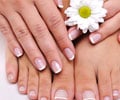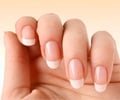- Surgery - (https://en.wikipedia.org/wiki/Surgery )
- Ancient Greek terminology in pediatric surgery: about the word meaning - (https://pubmed.ncbi.nlm.nih.gov/16818068/)
- Sushruta - (https://en.wikipedia.org/wiki/Sushruta)
- Statistical Brief #223Surgeries in Hospital-Based Ambulatory Surgery and Hospital Inpatient Settings, 2014 - (https://www.ncbi.nlm.nih.gov/books/NBK442035/)
- Trauma of major surgery: A global problem that is not going away - (https://www.ncbi.nlm.nih.gov/pmc/articles/PMC7388795/)
- Percutaneous Transluminal Coronary Arteriography - (https://www.ncbi.nlm.nih.gov/books/NBK538158/)
- Cesarean Section - (https://www.ncbi.nlm.nih.gov/books/NBK546707/)
- Assessing Cosmetic Surgery Safety: The Evolving Data - (https://www.ncbi.nlm.nih.gov/pmc/articles/PMC7572219/)
- After Surgery: Discomforts and Complications - (https://www.hopkinsmedicine.org/health/treatment-tests-and-therapies/after-surgery-discomforts-and-complications)
What is Nail Fungus?
A fungal nail infection is caused by a fungus that affects the keratin make-up of the nail. Fungal nail infection is not limited to any particular part of the nail, but can affect all the parts of the nail, such as nail plate, nail bed, and root of the nail. The infection gradually develops into discolored, thickened, and mottled nails.
Toenail fungus occurs more frequently than fingernail fungus. Humid, regular nail damage, poor overall health, pre-existing conditions such as diabetes or psoriasis, and wearing uncomfortable footwear all increase your susceptibility to toenail fungus or fingernail fungus (1✔ ✔Trusted Source
Recent advances in therapies for onychomycosis and its management
Go to source).
What Causes Nail Fungus?
Nail fungus (toenail fungus and fingernail fungus) also called as Onychomycosis is one of the most frequent diseases that are caused by dermatophyte fungal infections. The most common microorganisms causing nail diseases are Trichophyton rubrum, yeast, especially Candida spp. and moulds (1✔ ✔Trusted Source
Recent advances in therapies for onychomycosis and its management
Go to source).
Disclaimer: The home remedies suggested here are not a substitute for treatment by doctors. It is highly advisable to seek an expert’s opinion. All the remedies listed here may not be suitable for everyone. It is recommended to check for allergies or do a patch test before using the remedy.
Home Remedies for Nail Fungus
Many herbs and extracts, decoctions or pastes, have been used since ages as home remedies for nail fungus by traditional practitioners and in folklore medicine in India. Here are some home remedies which may help in treating nail fungus.
Herbs that Heal
There are a large number of natural antifungal preparations and supplements that form an essential part of home remedies for nail fungus. Some of these are:
- Snakeroot extract is obtained from Snakeroot plant, which belongs to the sunflower family. Snakeroot extract may help in suppressing nail fungus, when applied topically. According to a research, snakeroot extract had no side effects and helped in healing most of the people (2✔ ✔Trusted Source
Double-blind clinical trial for evaluating the effectiveness and tolerability of Ageratina pichinchensis extract on patients with mild to moderate onychomycosis. A comparative study with ciclopirox
Go to source). - Pau D’Arco also called as Tabebuia avellanedae is a tree, found to be effective in treating fungal infections. Pau d’Arco means “bow tree” in Portugal. It is effective in reducing fungal infections, but it can be unsafe when used in large doses. Hence, caution needs to be exercised while using it (3✔ ✔Trusted Source
Synthesis and evaluation of bioactive naphthoquinones from the Brazilian medicinal plant, Tabebuia avellanedae
Go to source). - Oregano oil is not only blessed with antifungal properties but also has potent antiviral and antibacterial effects. According to a study, the topical application of oregano oil is an effective and safe option for treating nail fungus (4✔ ✔Trusted Source
An Open Study to Evaluate Effectiveness and Tolerability of a Nail Oil Composed of Vitamin E and Essential Oils in Mild to Moderate Distal Subungual Onychomycosis
Go to source).
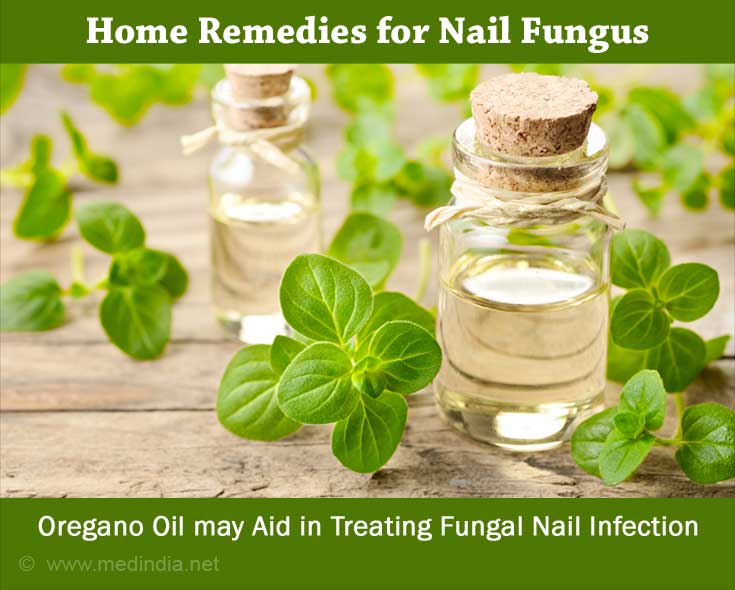
- Lemongrass herb is also used for its effective antifungal properties. In a published article, lemongrass herb has both antifungal and antibacterial properties, which may help in treating nail fungus. However, caution needs to be exercised as excess consumption may yield side effects like allergic reactions, frequent urination, dry mouth, tiredness etc (5✔ ✔Trusted Source
Therapeutic benefits of lemongrass and tea tree
Go to source). - Horopito is a plant with some active chemicals such as polygodial, which may inhibit nail fungus from spreading.
- Anise seeds are obtained from the plant Pimpinella asisum and have various medicinal properties. The chemical components present in anise seeds are effective against fungus, and hence, may help in curing nail fungus.
There are certain healthy bacteria which may be used in treating nail fungus. It works by competing with the fungus for nutrition and inhibiting its growth.
Other plant extracts that have also shown beneficial antifungal effect in nail fungus cure are essential oil of Eucalyptus, alcoholic extract of neem leaves and extract of Catharanthus roseus leaves. A significant factor to be considered while treating nail fungus at home is that any home remedy requires regular usage for a long period of time.
Tea Tree Oil
Tea tree oil is derived from Melaleuca alternifolia shrub like tree which is native to Australia. It has both antibacterial and antifungal properties. It is a popular home remedy used in the treatment of nail fungus. Easily available at health food stores, it has shown results comparable to those of clotrimazole in the treatment of the nail fungus infection. It has been reported that when tea tree oil is applied twice a day, improved the overall appearance of the nail when used regularly (6✔ ✔Trusted Source
Comparison of two topical preparations for the treatment of onychomycosis: Melaleuca alternifolia (tea tree) oil and clotrimazole
Go to source).
Olive Leaf
Olive leaf has beneficial effects against the fungal infection and also improves blood circulation. It may be used as a treatment against yeast infections. Olive leaf extract is one of the best nail fungus treatments. The use of olive leaf oil is a safe and natural way for nail fungus cure. Olive leaf oil is available in the form of tinctures, capsules or salves. Olive leaf extract can also be taken orally in a dose of one to three capsules twice a day with meals. It is important to get a medical opinion before consuming this capsule (7✔ ✔Trusted Source
Evaluation of the antifungal activity of olive leaf aqueous extracts against Candida albicans PTCC-5027
Go to source).

Garlic
Garlic has been popular as a home remedy in folklore medicine. Garlic may serve as a home remedy for nail fungus, because of its antimicrobial properties. Garlic is easily available in your kitchen and is one of the easiest and painless home remedies for nail fungus. Several chopped cloves of garlic can be placed in your socks at night to alleviate the initial stages of infection. As an alternative treatment, some fresh cloves should be crushed and placed on the affected area for about 30 minutes after which it can be washed off with water.
Garlic powder is also easily available, and a light dusting of it may be utilized to lessen nail fungus. Garlic oil ointment may be used as it is inexpensive in treating nail fungus. Garlic oil can also be prepared at home by mixing one tbsp of fresh chopped garlic cloves, three tbsp of coconut oil and one tbsp of olive oil.
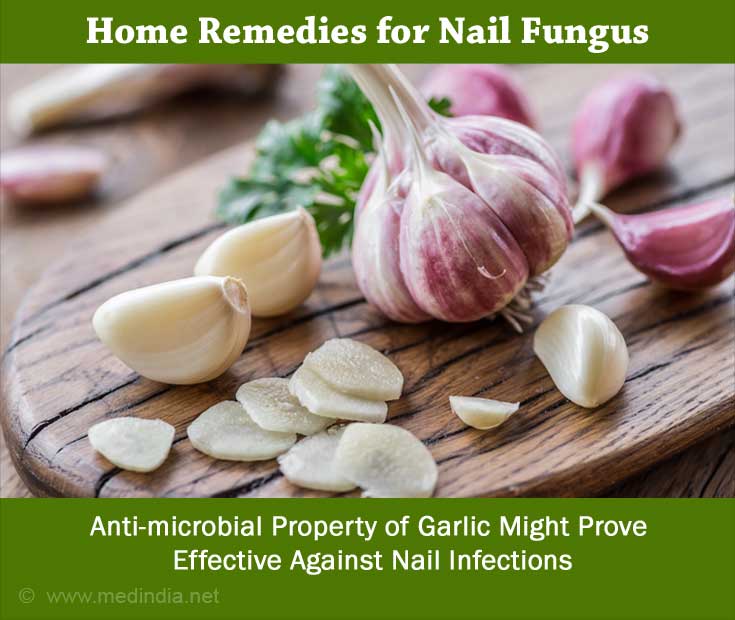
Ozone Therapy
Ozonated olive oil may help in inhibiting nail fungus. It must be applied onto the affected nail for 2-3 times a day for several weeks in a row. Ozone bagging, which involves putting your fingers in a bag filled with ozone gas, may help in treatment for fingernail fungus.
Vicks VapoRub
There is some evidence suggesting that the use of Vicks VapoRub may lead to improvements in the signs and symptoms of nail fungus. A small amount of the Vicks VapoRub is applied with the help of a cotton swab on the affected area for the treatment of toenail fungus.
Betel Leaf
Betel Leaf (Piper betle), has antifungal properties. Take some crushed betel leaves and salt, boil it in water. According to a study, betel leaves helped in inhibiting fungal activity (8✔ ✔Trusted Source
Antifungal activity of solvent extracts of Piper betle and Ocimum sanctum Linn on Candida albicans: An in vitro comparative study
Go to source). Soak the infected nail in this solution or dab it on the infected nails using a cotton ball. Continue this for 4 to 5 weeks which may help in reducing the strength of the infection.
Keep it Clean and Trimmed
It is important to keep your nails clean and trimmed as it helps in alleviating pain as well as in maintaining nail hygiene. Trim your nails and thin them by filing them. Apply a nail softening cream before you trim the nail. Urea cream can be applied after trimming and thinning and then covered with a bandage. This should be washed off with soap and water, and the process should be repeated until your nails soften. Use petroleum jelly on the skin around the affected nails.
The best nail fungus treatment you can give to your nails is being particular and meticulous about maintaining the hygiene of your foot to prevent infection. Doctors have stated that the recurrence of nail fungus is a major problem related to its treatment. To keep the toenail fungus at bay always ensure that while clipping your nails, you clip them short to match them with the contours of your toes and fingers. Always cut the nail straight across, so that there are no in-grown toenails.
If you have to take a shower in a communal area, always wear rubber shoes, flip flops, or shower clogs. Change your socks regularly if they are prone to sweating. Use over-the-counter antifungal drying powders to keep your feet dry all the time.
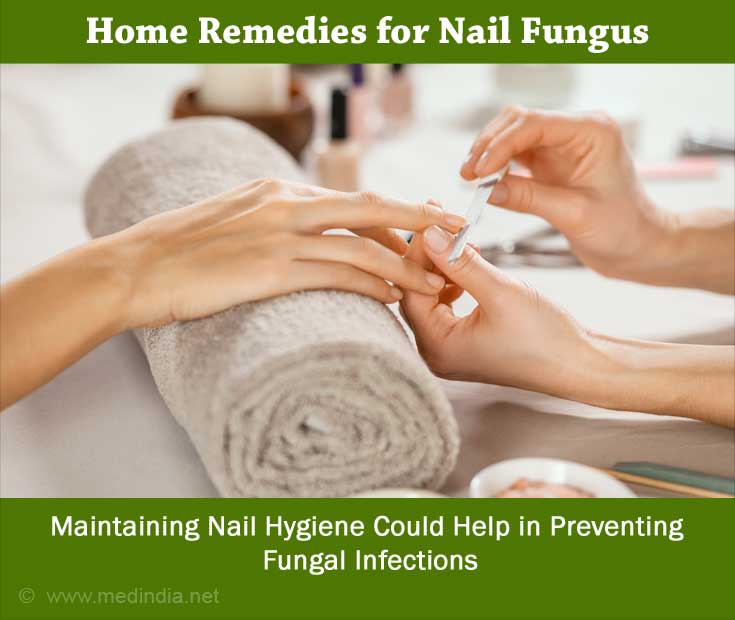
Nutrition
The incorporation of protein, folic acid, and essential vitamins in daily diet is extremely important for healthy nails. Essential fatty acids are also important for the good health of nails. Individuals trying to maintain glossy and healthy nails should include foods such as fish, flaxseed, canola oil, seeds, leafy vegetables, and nuts in their regular diet.
Prevention is Better Than Cure
The best nail fungus cure is to prevent the exacerbation of the infection. Various cleanliness measures should be followed regularly. Keep the feet clean and dry most of the time during the day. The skin between the toes and fingers should be dry, Don’t walk barefoot in areas like sand or dirty water and any flakes on the skin below the toes should be removed with the help of a dry tissue paper of gauze. Always use light socks which can adsorb moisture and improve the flow of air. Synthetic materials should be completely avoided and try to use open sandals or shoes with porous soles and upper surface.



